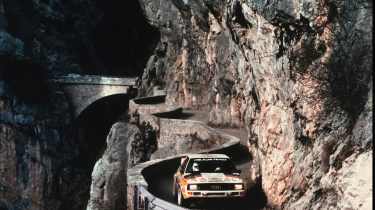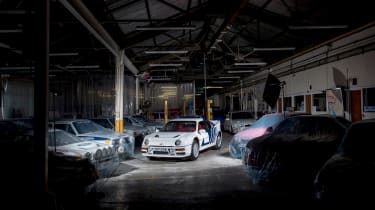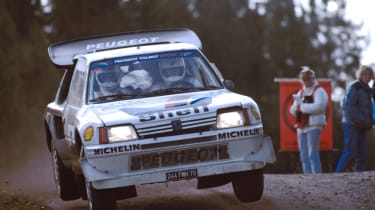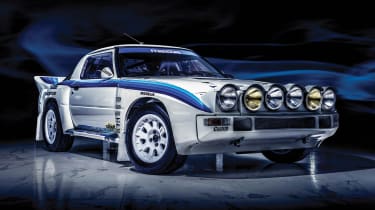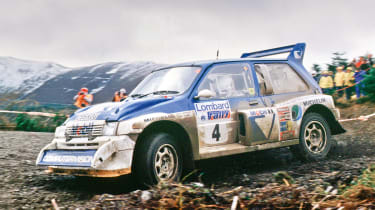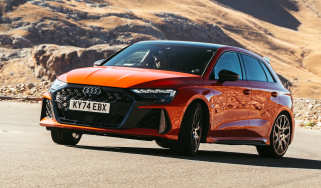The anatomy of a Group B rally car - history and tech of rallying's golden era
Unprecedented levels of power, excitement – and controversy. Group B rallying had it all. We take a look under the skin of the famous cars
Many still look back on the Group B era as the golden age of rallying. Even 30 years after it was banned, for power, excitement and controversy, it still takes some beating. Many of the Group B drivers have become legends and the cars retain a place in the hearts of fans having enthralled a generation with their performance and pushed boundaries with their technology.
Here we look back at Group B with particular attention to the amazing machines that competed and the homologation road cars they spawned.
The birth of Group B
The early ’80s saw major change sweep through international motorsport, with new Group N, A, B and C rules replacing the Group 1-6 regulations that had held sway for decades. Suddenly teams and manufacturers faced new challenges – and new opportunities. Group N and A cars had to be built in 5000 units or more, with the former in particular allowing very little scope for performance modification and the cars having to adhere to certain interior measurements and have at least four seats.
Group B was very different. It was intended as a replacement for both Group 4 in rallying and the Group 5 silhouette formula used in circuit racing, the latter having spawned such cars as the brutal, Porsche 911-based Porsche 935. The plan was that 200 examples had to be built over a 12-month period, and this time just two seats were required. Teams could apply Group A-style modifications to the cars to bring them up to competition specification, the idea being to allow and encourage more exotic, low-volume machinery. This way it would be easier for everyone to ‘build a Lancia Stratos’.
Not only was this half the number of units that had been required for Group 4 homologation, but an ‘evolution’ clause sought to eliminate the ‘optional parts’ rule that manufacturers had used to get trick bits onto their rally cars, passing them off as spurious dealer-fit options. These extra 20 evolution cars, while retaining the passenger compartment and basic layout, allowed for areas such as engine displacement, aerodynamics and the structures front and rear to be modified. A manufacturer could introduce a new evolution model every 12 months, but if it wanted to change anything fundamental a further 200 cars would have to be built as an entirely new homologation model. Triggering a run of evolution cars meant production of the cars used for the 200 original homologation models had to be stopped.
John Davenport was director of motorsport for British Leyland, latterly Austin Rover Group, and remembers the negotiations well. ‘There were two powerful lobbies when the manufacturers were discussing the new rules with FISA during 1979 and 1980,’ he recalls. ‘Those that wanted a very small production run to qualify, like us, Opel, Lancia and the Japanese manufacturers, and those that wanted a run of thousands, such as BMW and Ford. They already made sporting cars that would have just then needed the right regs to tune up. What we ended up with was the 200-car rule, which was neither one thing or the other.’
> Click here for our Ford Focus RS Mountune M400 review
Over at Ford Motorsport, chief rally engineer John Wheeler also remembers the pain of producing homologation cars. ‘Building 400 cars for Group 4 was a massive task for a manufacturer,’ he says. ‘The cost of design and development was huge – mega millions for the entire project. It’s only when you get down to 20-or-so cars that you can look to build them in racing workshops.’
As it was, in most cases the manufacturers viewed the 200 road cars as a necessary evil and never actually went rallying with them, competing with the evolution models that were more like pure prototypes. ‘It took us 18 months to put the road cars into production,’ adds Wheeler. ‘We were scheduled to make our competition debut in October 1985, but the stress of setting up a factory from scratch delayed things.’ Ironically, given events to come, FISA promised rule stability until the end of 1987, with a two-year notice period of any major changes.
What a manufacturer could build was unfathomably relaxed by the standards of modern motorsport regulations, with their endless pages of prescriptive rules, air restrictors and common-to-all parts. Essentially, there was a matrix of displacement, weight and wheel width, into which every car could fit. The regs ran from 1 litre up to 5 litres-plus, but the key categories for rallying fitted between 2 and 4 litres. Cars with engines up to 2-litre displacement had a minimum weight limit of 820kg (Renault’s 5 Turbo was in this category), rising to 4-litre machines that could weigh no less than 1100kg. An equivalency factor of 1.4 was applied to engines with forced induction, so, for example, the up-to-2.5-litre class meant a turbocharged engine of no more than 1785cc and a weight of 890kg. The Peugeot 205 T16 and Lancia Delta S4 fell into that particular category, while the turbocharged 2121cc Audi Quattro and naturally aspirated 3-litre Metro 6R4 both fell into the 3-litre class. The 4-litre class included the Porsche 959 and Ferrari 288 GTO, the Ferrari in particular intended for Group B circuit racing – a form of racing that never materialised.
> Click here for our Audi RS5 review
So far, all so innocent: in 1982 there was nothing alarming about a Group B car at all, it was just another means for creating a rally car championship. Consider Lancia’s first attempt at a Group B car, the delicate 037, which arrived for the start of the new regulations. A light, two-seat sports car with a small, supercharged engine powering the rear wheels only, it was just the sort of car FISA had intended in so many ways. Its great rival, the Audi Quattro, was actually a carry-over from the Group 4 days, but in its genes laid the root of everything that was to follow, for good and for worse.
Drivetrain & chassis
‘No one had been thinking four-wheel drive when Audi came along with the Quattro,’ says Austin Rover man Davenport. ‘Up to that point, four-wheel-drive cars were perceived as useless.’
Lancia had its 037, and Ford was working on a new rear-drive Escort that did at least use turbocharging – the ill-fated RS1700T – yet history now shows us it was wasting its time. Four-wheel drive changed everything, slashed seconds and even minutes off stage times, and opened the door to far greater useable horsepower. After all, there was only so much power that could be deployed through the rear wheels on a loose-surface stage, even if you could generate it in the first place.
> Click here for our Audi TTRS review
Nevertheless, it was also obvious to the engineers of rival teams that Audi’s approach was fundamentally flawed. Sticking to its production-car roots, the Quattro slung its in-line ‘five’ way out beyond the front axle with fairly disastrous implications for the handling balance. Moreover, Audi even retained a locked centre differential for years.
What was required was a much more favourable weight distribution. Both Ford and Austin Rover experimented with front-mid-engine layouts but found packaging an engine and four-wheel-drive running gear impossible. Both then put the engine in the middle, the Ford RS200 featuring the gearbox up front for arguably the most benign balance in a Group B car.
However, the car that first showed what could really be possible was the Peugeot 205 T16, which made its competition debut on the Tour de Corse in 1984. Compact, mid-transverse-engined and with four-wheel drive, it was a rallying supercar, even in original 340bhp form, and took both the drivers’ and manufacturers’ titles in ’85 and ’86.
> Click here for our Peugeot 208 GTi review
That said, what dates a Group B car – other than the sheer, hypnotic potential for utter danger – is its suspension and four-wheel-drive system. The art of four-wheel drive was just being understood, and even to drive something like the road RS200 in these images is to experience a drivetrain of astonishing crudity. The Ford had perhaps the most advanced suspension of its day with its twin-rear-damper setup, but, compared with the astonishing capabilities of a 2017 WRC car and its magic carpet ride, it is from the Iron Age. No wonder Group B stage times have long since been surpassed in the latter years of the WRC.
Engine & gearbox
Looking back, it’s easy to feel sorry for embattled Austin Rover. Having decided to go with a V6 engine for its Metro 6R4 because there was nothing else suitable in its inventory, it was committed to a non-turbo configuration based around the displacement and weight rules. ‘FISA were supposed to be controlling the fuels,’ recalls Davenport drily, ‘and there was no reason a 3-litre naturally aspirated engine of 400bhp shouldn’t be competitive with a turbocharged 1.7-litre engine. But the teams were using high levels of toluene – it was just ridiculous.’
Ah yes, C6H5-CH3, or toluene to you and me: the colourless but evil-smelling octane-boosting aromatic hydrocarbon that contributed so much to the turbocharged madness of the 1980s, whether in F1 or in the WRC. Used by the Luftwaffe in World War II, its octane-boosting qualities combined perfectly with the relatively new art of turbocharging and, crucially, the emergent electronic control of fuel injection. ‘The gains in electronics were very rapid,’ recalls Ford man Wheeler. ‘We started at Boreham in 1983 with the Escort RS1700T and Bosch, and you wouldn’t believe the size of the testing equipment they’d cram into the passenger seat. But it was incredible what they were up to – Dr Udo Zucker was a complete genius.’
> Click here to see all the details on the 2018 Ford Fiesta ST
More than anything else, it’s raw power that defines the Group B era. By 1986 there was a 500 club: the E2 S1 Quattro with at least 550bhp, maybe more; the turbocharged and supercharged Delta S4 with incredible response as well as immense power; and the Evo 2 T16, at least when fitted with an F1-spec turbocharger, as the team tried.
And just imagine what might have come later. For 1987 Ford planned to introduce the first evolution of the RS200, having bucked the trend by rallying the original ‘200-build’ car in its first year. The ‘evo’ put right one of the original car’s main weaknesses: 444bhp in 1986 just simply wasn’t enough. The larger 2.1-litre BDT engine moved the car to the optimum point in its displacement/weight class, and would have given the RS200 a reliable 650bhp from the start of the season.
In 1985 there had also been the first major step forward in gearbox tech, with Audi introducing the twin-clutch PDK transmission on the Quattro. It was heavy but increasingly effective and, given what we know now of transmission technology, it would surely only have been a matter of time before semi-automatic ’boxes became the class norm.
Body & aerodynamics
The Group B cars were a riot of carbonfibre, Kevlar and plastic panels, the like of which hasn’t been seen in rallying before or since. With virtually no restriction on what could and couldn’t be used, only budgetary concerns provided any limitation – and this was an era when motorsport attracted an almost- limitless resource from the major manufacturers.
Unlike modern motorsport, where higher minimum weight limits mean cars are often ballasted to reach the target figure, it was genuinely hard for manufacturers to get their cars light enough, despite using advanced materials only seen otherwise in F1. Audi struggled and, as Davenport confirms, a 6R4 only hit the 960kg minimum in sprint spec, struggling to fall below the ton for longer events where more strength was required.
For Audi, aerodynamics offered a way of clawing back some of the handling deficit, and the wild E2 S1, with its snowplough front end and roof-high rear wing, was a spectacular example. Peugeot Sport introduced a massive rear wing for the Evo 2 version of the T16, in part through necessity to maintain its trajectory over high-speed jumps. And Austin Rover incorporated real aero from the start: ‘The cars were pretty basic to drive, not easy at all,’ remembers Davenport, ‘but the aero improved that. We couldn’t believe the difference. It turned the 6R4 from a ratty thing to predictable, at least in the hands of the talented drivers we had.’
> Renault 5 Turbo: birth of an icon
The end of Group B
On 2 May 1986, Lancia’s superstar driver, Henri Toivonen, and his regular navigator, Sergio Cresto, were leading the Tour de Corse rally with ease. Toivonen was the golden boy of Group B: young, charismatic, fast and fearless. He was the only one of Lancia’s crack driving squad to truly tame the ferocious yet ungainly Delta S4, a car that in many ways summed up everything that was good and bad about Group B rallying.
Exactly why Toivonen and Cresto left the road on a seemingly innocuous corner has never been established, but the Lancia appeared neither to brake nor turn before it tumbled down the hillside, bursting into a fireball almost on impact with the trees. The S4 had much in common with a sports prototype racing car from the 1960s, with a simple tubular spaceframe chassis and the crew actually sat on fuel tanks with minimal protection; the pairing didn’t stand a chance. Group B was immediately banned from the end of the year, and its – safer – intended Group S replacement along with it.
Even today, it’s a deeply emotive topic. Another senior engineer from the period, who wished to remain anonymous, had this to say: ‘The root of all evil was the weight classes – they were ridiculous. They bore no relation to building a safe car. You just can’t get a car down to 960kg with turbochargers and all that tech and have safe cars. If it had been, say, 1180kg, and with certain rules on safety cells, it would have all been fine.’
Toxic, extremely flammable fuel; rules that allowed freedom but stipulated little on safety; spectators who stood where they liked in their thousands; rallies many times longer than those of today… Many things contributed to the demise of Group B. One thing is certain: we’ll not see its like again.

